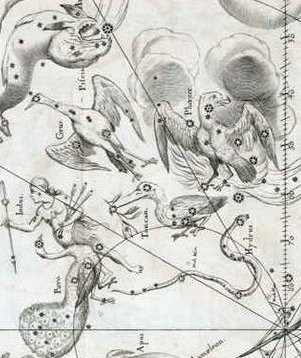We ought to look at glyph line Ca1 once more, first because the precessional history perhaps should be adjusted with 0.4 RA days and secondly because of my new rule for locating stars:
An easy way to perceive which new position in the text a star should have is to in your mind reduce the RA day number with 0.4 and then to look where the star should be according to my old rule. A change in the RA day number for a star will sometimes have effect on the position of a lunar station, e.g. will the change of Algenib Pegasi from March 23 to March 22 necessitate a parallel change of Uttara Bhādrapadā and Wall. By the way, I have now come to believe (earlier it was just a guess) that Ca1-1 indeed depicts the time when sky and earth were still joined together in 'close embrace' - this follows from the 'Reef' not yet having arrived and from Metoro's word koia: ... he-mama i te vai tôa koia ko te tiapito kiroto ki te haha o te poki, she mouth-feeds the child with sugarcane juice together with tiapito juice ... Also Metoro's comment ki te hoea at Ca1-2 should now be interpreted anew - Sun would ideally not return until April 17 even though the type of glyph is tara. But I do not have to change my previous statement: ... Metoro said ki te hoea when commenting on Ca1-2 and it may have been his way of telling Bishop Jaussen that this was the equinox when the light halfyear changed to the dark halfyear. March is not a spring month south of the equator but its opposite. Metoro may have thought so, or he may have thought about April 17 not yet reached, or he may have thought of both at the same time. Or there could be some other explanation. The first pair of glyphs can be imagined as corresponding to 'a first pair of star signs' (Al Sharatain) at the March equinox. They seem to emerge from the fogs of dawn with only their top (front) parts visible. The force of gravity points the arrow of time downwards but then the force of growth turns the arrow of time upwards. 5 fully visible glyphs follow with the star pair Ankaa and κ Phoenicis in the center, perhaps alluding to the 'creation of fire' (light) by separating Sky and Earth, cfr Ca1-6. But the rising kahi in Ca1-7 has not yet opened his mouth - perhaps because April 17 was still in the future, and this could explain why Metoro said te ika:
If there should be a connection with the years I have arranged in parallel with the glyphs, then Pope Gregory XIII and his calendar reform would be between Ca1-3 and Ca1-4: ... Gregory dropped 10 days to bring the calendar back into synchronisation with the seasons. Accordingly, when the new calendar was put in use, the error accumulated in the 13 centuries since the Council of Nicaea was corrected by a deletion of ten days. The Julian calendar day Thursday, 4 October 1582 was followed by the first day of the Gregorian calendar, Friday, 15 October 1582 (the cycle of weekdays was not affected) ... But I cannot see any sign of him nor of his calendar reform. Columbus discovered America (a new land) in A.D. 1492. I have above inserted a gap between puo ('hilled up) in Ca1-5 and the picture of separation in Ca1-6. In the G text a puo is the last glyph on the back side of the tablet and counting beyond March 26 (85) there are precisely 40 weeks (280 days) to the end of the Gregorian year. Maybe we should rearrange the first 7 glyphs into a pattern with 2 + 3 + 2:
|




